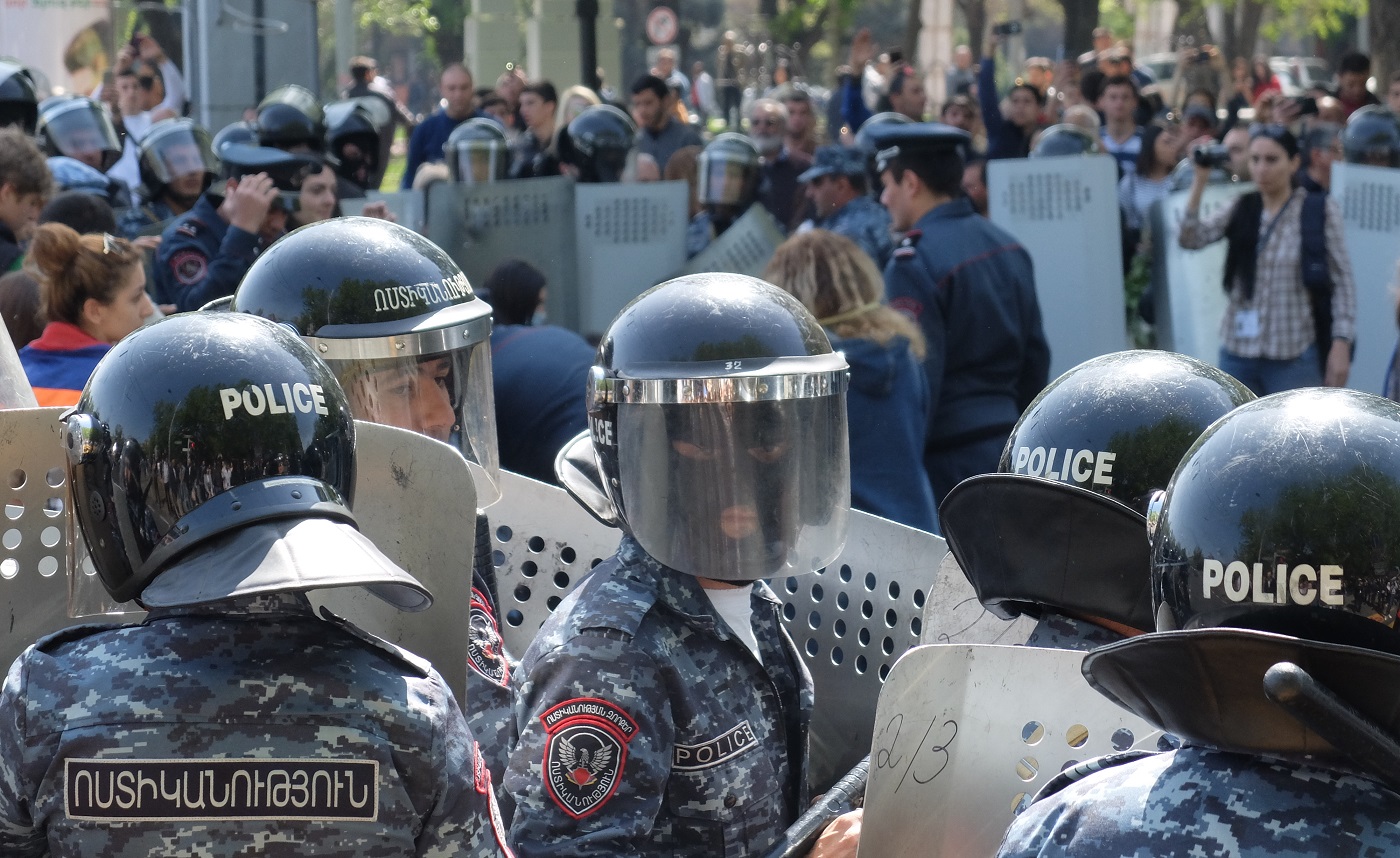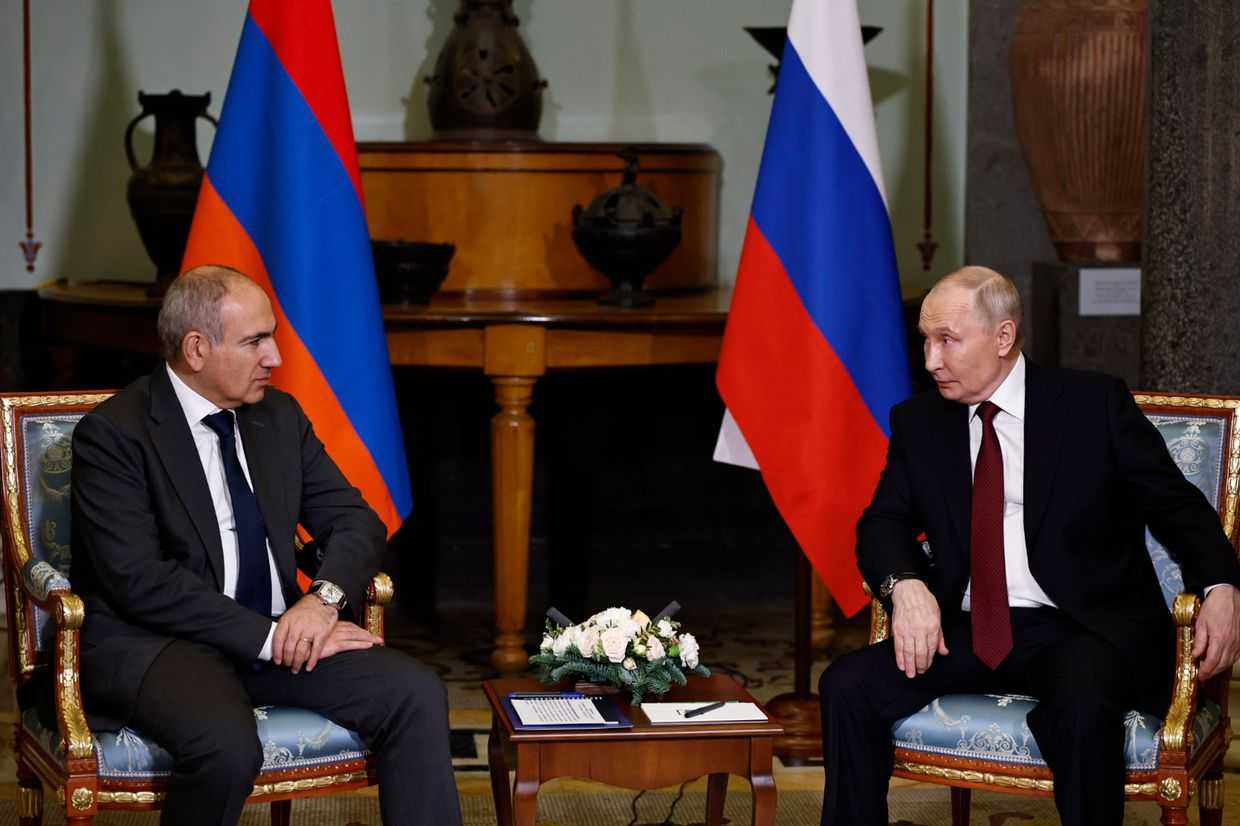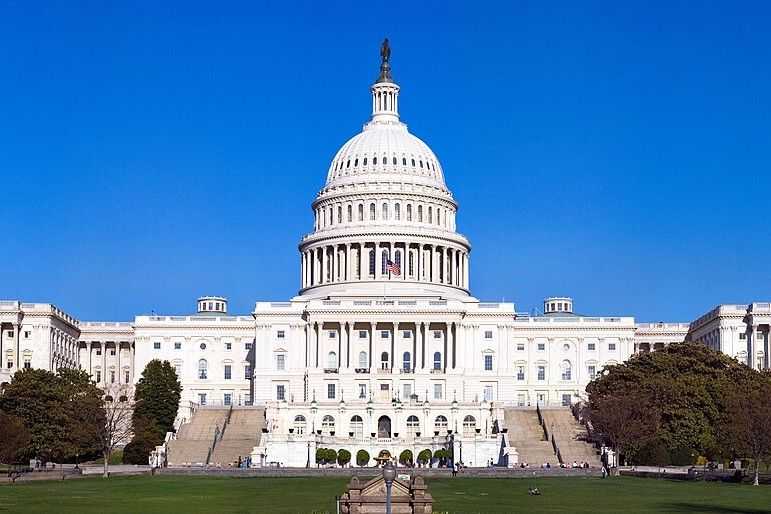

Reform of the oft-maligned Armenian Police Force is in full swing following April’s ‘Velvet Revolution’, with reformers frequently citing neighbouring Georgia as a blueprint. While the reforms seem to have made a real dent in corruption, calls to take on the force’s reputation for brutality appear to be gaining less traction.
‘Ashot, your grandmother is in this crowd! Will you hit her, too?’ A protestor screams at a riot police officer at the height of Armenia’s April 2018 revolution.
Within hours, the video had gone viral, becoming a symbol of the protests. The crowds quickly adopted a new chant encouraging police to break rank and join them: Vostikany mern e! (the police are ours). The implication was that the police were a part of the people, too — and they want freedom just like everybody else.
(Radio Azatutyun / YouTube)
‘From now on, the people should demand that all officials serve the people honestly and devotedly’, protest leader Nikol Pashinyan said in his victory speech on 8 May, after being appointed Prime Minister of the country.
In a consultation meeting on 7 November, Pashinyan reflected on a series of ‘new tasks set before the Armenian police force’, which Chief of Police Valeri Osipyan is calling a systemic reform.
Pashinyan states that one of the top priorities of the reforms is to ‘change the attitude of citizens towards the police, and vice versa’ — in other words, to increase public trust and make the police force friendlier to the public.
Nelli Manandyan, Deputy Head of the Armenian Police’s Legal Department, identifies the traffic police as the department with the most contact with the public.
‘The most important thing [the reforms have achieved thus far] is that the attitude of police officers has been changed, especially the traffic police’, Manandyan tells OC Media.
They’ve received many complaints about the traffic police, she says. These are being used to guide the priorities of the reforms, including the sweeping anti-corruption measures in the police bodies citizens interact with every day. But many report that even with the reforms, Armenia’s police force is not without problems.
‘What human rights defenders and civil society stress is that this is not about the patrol police’, Tatevik Khachatryan of the Open Society Foundation tells OC Media.
‘The gravest human rights violations attributed to the Armenian police are not attributed to the patrol police — they’re attributed to the police forces that are used to disperse peaceful rallies, and those who are responsible for detentions.’
According to Khachatryan, those departments outside of the traffic police may not be undergoing as intense of a change as they need to be: ‘Torture and ill-treatment has not ended in police detention centres’, she says.
Picking priorities: What Armenia has learned from its neighbour
A taxi driver watches attentively as, across the street, a car gets pulled over by a police officer for an illegal U-turn. ‘It’s nice’, he says, ‘since the revolution, you only get pulled over if you’ve done something illegal’.
Norayr, one of the city’s many cab drivers who has watched Yerevan through its political turmoil, is tapping into something many Armenians talk about. Until the revolution, Armenians were subjected to rampant bribery stops, in which traffic police officers would stop drivers at random to demand money; they came to a sudden halt as the government changed.
Indeed, one of the first changes introduced by new Chief of Police Valeri Osipyan is a zero-tolerance policy towards bribery and corruption to help filter out the officers unwilling to move away from the previous system.
As Manandyan explains, it’s very straightforward: Any police officer who is found taking a bribe will be promptly fired.
‘We had some officers who went to Georgia’, she says, to gather information about how to recreate the effects of their neighbour’s post-revolutionary reforms.
Mikheil Saakashvili’s sweeping police reforms involved simply dismissing the entire traffic police force and building it from scratch. It is this top-to-bottom re-haul that the new zero-tolerance policy is hoping to emulate. ‘We want to use their experience’, she says, ‘and they’ve agreed to help us’.
However, Armenia has one important obstacle to face if these reforms are to reproduce Georgia’s much-lauded experience. Junior officers in Armenia can receive as little as ֏110,000 ($230) per month, only 55% of the average wage.
One border patrol officer told OC Media that he supported Pashinyan and his revolution, but was concerned about the reform process: He and his colleagues relied on bribes to complement their salaries and were now unexpectedly facing economic hardship.
Georgia had a similar problem before 2003, which is why one of Saakashvili’s first moves in his reforms was to dramatically increase police salaries.
Beyond cutting the incentive for bribery, the salary increase also allowed the re-hiring process after his famous institution-wide dismissal, to be more rigorous and to demand higher standards and qualifications from applicants.
But Saakashvili had something that Pashinyan does not: Extensive American and otherwise Western financial and political support, which helped fund the police reforms.
Armenia, however, is not so lucky: It is not sitting in as geopolitically advantageous a position as Georgia was in 2003, and most development grants it is eligible for explicitly forbid the use of funding for salaries, explains Khachatryan.
In June, Osipyan announced that the government would cut the number of officers and increase the salaries of the rest by January. However, as of August, Manandyan told OC Media that the Police were currently ‘considering’ a salary increase — and there has thus far been no news of the increase since.
Electoral fraud — a thing of the past?
Another crucial cornerstone of the new reform is the police’s dramatically improved reaction to electoral fraud. ‘They were super effective’, says Khachatryan about their performance during the municipal elections of Yerevan this September.
‘They put in place so many efforts and so many good people because the assignment came from the very top. Nikol Pashinyan said that this election should be an example for our society. [The people] should see how the police have changed.’
Indeed, the election was championed throughout the country as a great success. The parliamentary elections of 9 December also saw a huge improvement: ‘There is a big difference from other elections […] there are no machinations’, one voter from Erebuni told OC Media.
Most citizens, journalists, and human rights observers alike affirm that the elections were free of the electoral malfeasance that Armenian voters have become accustomed to, like vote-buying and other forms of pressure.
After tackling petty corruption in the traffic police and hosting Armenia’s first and second indisputably free elections, the police force are taking on another sensitive issue: police violence during protests.
There have been many reports of Armenian police using violence as a form of political repression, as happened during the Electric Yerevan protests of 2015, or, most notoriously, on 1 March 2008 during protests against the election of former prime minister Serzh Sargsyan.
Khachatryan remembers receiving a record number of police brutality reports on 22 April 2018, the day before Sargsyan’s resignation.
This is in direct contrast with what has occurred since the revolution. The past six months have seen a few protests about a variety of topics, including for the freedom of Sasna Tsrer (the Daredevils of Sasun), against the Republican-aligned Armenian Catholicos, and against some Republican-aligned village heads.
During these events, Khachatryan reports that protestors noticed remarkably little violence from the police, if any.
The same faces
Despite the police’s performance thus far, many still have some concerns.
Khachatryan speaks about the attitude some officers take towards the training that is intended to help shape the new police force.
‘Whenever I talk to lay policemen about the reforms, they say “You know, they might send me to Europe or the US for a training”. All they’re interested in about the reforms is to travel to nice places.’
Her anecdote is illustrative of a broader trend reported by many human rights observers. ‘We have a new Chief of Police, and a government vision for reforms in the field [of policing]’, says Armenak Minasyants, secretary of Armenian rights group Article 3.
He sees in the new government a real desire for reform. But this ambition is threatened, he says, because ‘the people who used to be part of corruption mechanisms are now supposed to advance the reforms […] The same people who were in service seven months ago are in service now’, Minasyants tells OC Media.
Police brutality — ‘a normal part of policing’ in Armenia
Khachatryan points out an oversight in all the anti-corruption rhetoric. ‘Pashinyan has kept repeating that we will not tolerate any bribery, we will not tolerate electoral fraud. But there is no specific message regarding regular crimes [committed by police].’
Yet, corruption is not the only type of crime that is committed by members of the police force.
Indeed, in the past few months, Khachatryan and her team have been notified of at least four separate instances in which violence has been used against suspects either to extort a confession, as punishment, or as another type of pressure.
The city of Sevan saw a particularly violent case on 7 October in which a man was brutally beaten, stripped, and humiliated by three local officers. They later attempted to bribe the victim not to press charges, and then were released after signing a document stating they will not leave the country.
Over two months later, no final decision on the case has been announced.
Conversely, the mistreatment of a Ukrainian street musician on Yerevan’s ritzy Northern Avenue this August fuelled a protest. Violent backlash against protesters create similar outrage.
Film producer Sona Margaryan explains that violence against foreigners attracts media attention, as does police brutality in times of protest, which is recognised as a direct form of political repression.
‘But outside of that, if someone just gets beaten during detainment, police brutality isn’t really reported on. It doesn’t get much media attention’, Margaryan tells OC Media.
Cases of brutality towards people like Ara Muradyan in Sevan have become heavily normalised in Armenia. Both before and after the revolution, ‘police brutality is treated as a thing that simply does not exist’, explains human rights activist Armenak Minasyants. ‘We don’t even discuss it. It’s a solved issue, it’s a done deal. We don’t need to get back to it.’
That lack of discussion, however, should not be mistaken for a lack of brutality. ‘We’ve had cases in which police brutality was even captured on camera’, Minasyants reports — and the perpetrators have faced no consequences.
Yet, during this reform process, he has seen no conversations whatsoever about police brutality, because violence is considered by most to be a normal, acceptable part of policing.
Robert Revazyan, a lawyer from the Armenian Helsinki Committee, explains that people don’t question brutality in the prison system for the same reason: they don’t question the assumption that violence is an effective method of crime prevention. Yet, he says, threats of violence ‘do nothing against crime’.
‘This problem has also been common in other countries’, highlights Minasyants. ‘It’s not a problem that’s only in Armenia. It’s a global problem, it happens everywhere — but in other places, there’s a discussion about it.’
He’s referring to a wealth of examples in which the effectiveness of brutality has been questioned. But in Armenia, even as the government’s legitimacy rested directly in the hands of the people during the revolution and until the 9 December elections, this basic assumption remained untouched, Ani Harutyunyan of the Open Society Foundation points out.
Towards a police of the people
‘Armenia is now an extremely vibrant society, and is very transparent’, says Minasyants. He has hope not just for the police reform and society at large, but for the power the people hold to put forwards the right conversation.
The problem, this time, is not an unwillingness on the part of the government or of the police to cooperate — it’s the scope of actions they see as necessary.
‘[Police officers] are acting only on specific assignments’, says the Open Society Foundation’s Khachatryan. ‘If they’re assigned to do something, they’ll do it zealously — if not, they will use their regular course of action. “We cannot interrogate a person in other ways, so we will torture them. They will confess sooner.” ’
Many people say they have seen a real, tangible change in their interactions with police on a day-to-day basis. Pashinyan cited these changes as a measure of success, but he, as well as Osipyan and Manandyan from the Armenian Police, all recognise the need for further changes and further reforms.
In this, at the very least until the reforms are completed, Khachatryan says the people have an opportunity to start probing deeper into the type of policing Armenians accept. ‘What is society’s expectation of the police right now? What is their new role in the new Armenia, in a new democratic setting? What should it be?’
Minasyants, for his part, has made his view clear: ‘We proclaimed during the revolution that the police belong to the people. So we believe the police should not beat us any longer’.








